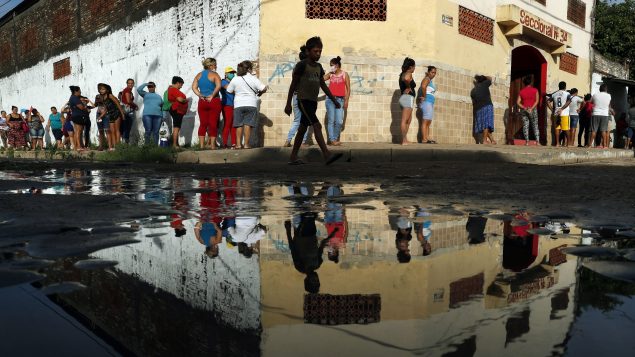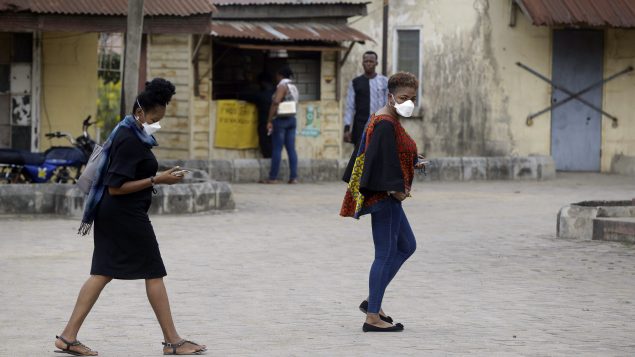The United Nations World Food Programme (WFP) says it needs nearly $6.6 billion as it mounts the largest humanitarian response in its history to feed millions of people pushed into hunger by the devastating socio-economic impacts of the COVID-19 pandemic.
The UN agency estimates the number of acutely food insecure people could increase by 80 per cent – from 149 million pre-COVID-19, to 270 million before the end of 2020 – in the 79 countries where it works.
Julie Marshall, the Canadian spokesperson for the WFP, said the epicentre of the COVID-19 pandemic is shifting from the richer countries to the poorer countries, bringing hunger with it.
“The poor are getting poorer and the hungry are getting hungrier once again,” Marshall told Radio Canada International in a phone interview.
“And it couldn’t really come at a worse time because we’re seeing infection levels climbing right at the time when millions of people are out of work, food stocks are low, because farmers are waiting for their new harvests to come in, and, of course, it’s starting on the hurricane and monsoon season, and then you have record locust invasion in East Africa already adding to the world’s hungry.”
- 265M people will starve in 2020 if no immediate action is taken, UN warns
- COVID-19 could push 10M additional children into acute malnutrition: UN
Low- and middle-income countries all over the world will be hit particularly hard, Marshall said.
“Things like social unrest, protest, rise in migration, even deepening conflict – all of that is going to add to more people being hungry,” she said.
To tackle the rising tide of hunger in low- and middle-income countries, the WFP is ramping up the number of people it assists to up to 138 million from a record 97 million people it assisted in 2019, Marshall said.
“We thought that 2020 was going to be the worst year ever since the Second World War and that would be because of conflict, climate change, severe storms wiping out and crops and livelihoods, and the economic downturn,” Marshall said. “And that was all before COVID.”
Worries for Latin America and the Caribbean

Neighbors line up for free food staples outside the Santa Ana primary school in Asuncion, Paraguay, part of an already existing food program through the Education Ministry, as people stay home from work amid the spread of COVID-19, Tuesday, March 31, 2020. (Jorge Saenz/AP Photo)
The fallout from the pandemic is being felt hardest in Latin America and the Caribbean where the number of people facing hunger could quadruple to 16 million, representing the highest relative increase in food insecurity of any region in the world, Marshall said.
There is particular concern for Haiti, the so-called Dry Corridor of Central America, and Venezuelan migrants in Colombia, Ecuador and Peru. The plight of workers employed in the informal sector is particularly worrisome, as many are not covered by any social protection programs, she said.
Spikes in hunger are also evident in West and Central Africa which has seen a 135-per-cent jump in the number of food insecure people as well as in Southern Africa where there has been a 90-per-cent rise.
‘A toxic cocktail of armed conflict, population displacement and climate change’
“In West Africa, COVID-19 threatens to become an extra ingredient in the toxic cocktail of armed conflict, population displacement and climate change that has already resulted in growing rates of hunger and malnutrition across West Africa,” Marshall said.
WFP estimates that the number of acutely food insecure people in the region could more than double to 57.6 million, she said.
In Southern Africa, hunger is driven by the impacts of ongoing drought, flooding, conflict or economic crisis, and the pandemic is amplifying deep-rooted structural problems underpinning the region’s protracted hunger crises, Marshall said.
The region experienced normal rainfall only once in the last five cropping seasons, and in 2019, repeated extreme climatic shocks resulted in the highest peak acute food insecurity of the past decade, Marshall said.
WFP analysis shows that 42 million people could require food assistance this year in 12 countries in the region, up from 26 million in 2019. Should a worst-case scenario materialize, this figure could rise to as many as 52 million, Marshall said.

Women wearing face masks walk by the Yaba Mainland hospital, where an Italian citizen – the country’s first case of the COVID-19 virus – is being treated, in Lagos, Nigeria on Friday, Feb. 28, 2020. (Sunday Alamba/AP Photo)
In East Africa, the triple threat of acute hunger and displacement crises like those faced by South Sudan and Somalia, an outbreak of desert locust devastating crops in some countries, as well as extensive flooding across the region is exacerbated by the socio-economic fallout due to the pandemic, Marshall said.
WFP estimates that the number of severely food insecure people could – in the worst-case scenario – almost double to 41.5 million, she added.
In the Middle East and North Africa, the number of food insecure people in the region due to COVID-19 could be pushed to 53 million people.
In the Asia and the Pacific region, the number of people facing hunger are projected to be pushed to 49.6 million people, with concern for countries with high dependency on food imports, remittances, and economies reliant on exports.
The urban poor, informal labourers, low-paid workers involved in tourism and export industries are particularly at risk.
Marshall said she hopes rich countries like Canada will step up to the plate. Corporations and private citizens also have a role to play in averting the crisis, she said.







For reasons beyond our control, and for an undetermined period of time, our comment section is now closed. However, our social networks remain open to your contributions.